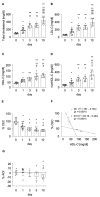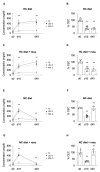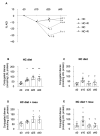Hypercholesterolemia-Induced HDL Dysfunction Can Be Reversed: The Impact of Diet and Statin Treatment in a Preclinical Animal Model
- PMID: 35955730
- PMCID: PMC9368958
- DOI: 10.3390/ijms23158596
Hypercholesterolemia-Induced HDL Dysfunction Can Be Reversed: The Impact of Diet and Statin Treatment in a Preclinical Animal Model
Abstract
High-density lipoproteins (HDL) undergo adverse remodeling and loss of function in the presence of comorbidities. We assessed the potential of lipid-lowering approaches (diet and rosuvastatin) to rescue hypercholesterolemia-induced HDL dysfunction. Hypercholesterolemia was induced in 32 pigs for 10 days. Then, they randomly received one of the 30-day interventions: (I) hypercholesterolemic (HC) diet; (II) HC diet + rosuvastatin; (III) normocholesterolemic (NC) diet; (IV) NC diet + rosuvastatin. We determined cholesterol efflux capacity (CEC), antioxidant potential, HDL particle number, HDL apolipoprotein content, LDL oxidation, and lipid levels. Hypercholesterolemia time-dependently impaired HDL function (−62% CEC, −11% antioxidant index (AOI); p < 0.01), increased HDL particles numbers 2.8-fold (p < 0.0001), reduced HDL-bound APOM (−23%; p < 0.0001), and increased LDL oxidation 1.7-fold (p < 0.0001). These parameters remained unchanged in animals on HC diet alone up to day 40, while AOI deteriorated up to day 25 (−30%). The switch to NC diet reversed HDL dysfunction, restored apolipoprotein M content and particle numbers, and normalized cholesterol levels at day 40. Rosuvastatin improved HDL, AOI, and apolipoprotein M content. Apolipoprotein A-I and apolipoprotein C-III remained unchanged. Lowering LDL-C levels with a low-fat diet rescues HDL CEC and antioxidant potential, while the addition of rosuvastatin enhances HDL antioxidant capacity in a pig model of hypercholesterolemia. Both strategies restore HDL-bound apolipoprotein M content.
Keywords: HDL dysfunction; diet; hypercholesterolemia; pig; statin.
Conflict of interest statement
The authors declare no conflict of interest.
Figures





Similar articles
-
Cholesterol Efflux Capacity, High-Density Lipoprotein Particle Number, and Incident Cardiovascular Events: An Analysis From the JUPITER Trial (Justification for the Use of Statins in Prevention: An Intervention Trial Evaluating Rosuvastatin).Circulation. 2017 Jun 20;135(25):2494-2504. doi: 10.1161/CIRCULATIONAHA.116.025678. Epub 2017 Apr 27. Circulation. 2017. PMID: 28450350 Free PMC article. Clinical Trial.
-
Platelet tissue factor activity and membrane cholesterol are increased in hypercholesterolemia and normalized by rosuvastatin, but not by atorvastatin.Atherosclerosis. 2017 Feb;257:164-171. doi: 10.1016/j.atherosclerosis.2016.12.019. Epub 2016 Dec 16. Atherosclerosis. 2017. PMID: 28142075 Clinical Trial.
-
Atherogenic Lipoprotein Subfractions Determined by Ion Mobility and First Cardiovascular Events After Random Allocation to High-Intensity Statin or Placebo: The Justification for the Use of Statins in Prevention: An Intervention Trial Evaluating Rosuvastatin (JUPITER) Trial.Circulation. 2015 Dec 8;132(23):2220-9. doi: 10.1161/CIRCULATIONAHA.115.016857. Epub 2015 Sep 25. Circulation. 2015. PMID: 26408274 Free PMC article. Clinical Trial.
-
Rosuvastatin: a highly effective new HMG-CoA reductase inhibitor.Cardiovasc Drug Rev. 2002 Winter;20(4):303-28. doi: 10.1111/j.1527-3466.2002.tb00099.x. Cardiovasc Drug Rev. 2002. PMID: 12481202 Review.
-
Pitavastatin: novel effects on lipid parameters.Atheroscler Suppl. 2011 Nov;12(3):277-84. doi: 10.1016/S1567-5688(11)70887-X. Atheroscler Suppl. 2011. PMID: 22152282 Review.
Cited by
-
A comprehensive assessment of the association between common drugs and psychiatric disorders using Mendelian randomization and real-world pharmacovigilance database.EBioMedicine. 2024 Sep;107:105314. doi: 10.1016/j.ebiom.2024.105314. Epub 2024 Aug 26. EBioMedicine. 2024. PMID: 39191171 Free PMC article.
-
HDL-Cholesterol and Triglycerides Dynamics: Essential Players in Metabolic Syndrome.Antioxidants (Basel). 2025 Apr 3;14(4):434. doi: 10.3390/antiox14040434. Antioxidants (Basel). 2025. PMID: 40298782 Free PMC article. Review.
-
Crosstalk between high-density lipoproteins and endothelial cells in health and disease: Insights into sex-dependent modulation.Front Cardiovasc Med. 2022 Oct 6;9:989428. doi: 10.3389/fcvm.2022.989428. eCollection 2022. Front Cardiovasc Med. 2022. PMID: 36304545 Free PMC article. Review.
-
The Influence of Metabolic Risk Factors on the Inflammatory Response Triggered by Myocardial Infarction: Bridging Pathophysiology to Treatment.Cells. 2024 Jun 29;13(13):1125. doi: 10.3390/cells13131125. Cells. 2024. PMID: 38994977 Free PMC article. Review.
-
Pearls before Swine: Plant-Derived Wastes to Produce Low-Cholesterol Meat from Farmed Pigs-A Bibliometric Analysis Combined to Meta-Analytic Studies.Foods. 2023 Jan 28;12(3):571. doi: 10.3390/foods12030571. Foods. 2023. PMID: 36766100 Free PMC article. Review.
References
-
- Keene D., Price C., Shun-Shin M.J., Francis D.P. Effect on Cardiovascular Risk of High Density Lipoprotein Targeted Drug Treatments Niacin, Fibrates, and CETP Inhibitors: Meta-Analysis of Randomised Controlled Trials Including 117,411 Patients. BMJ. 2014;349:g4379. doi: 10.1136/bmj.g4379. - DOI - PMC - PubMed
-
- Voight B.F., Peloso G.M., Orho-Melander M., Frikke-Schmidt R., Barbalic M., Jensen M.K., Hindy G., Hólm H., Ding E.L., Johnson T., et al. Plasma HDL Cholesterol and Risk of Myocardial Infarction: A Mendelian Randomisation Study. Lancet. 2012;380:572–580. doi: 10.1016/S0140-6736(12)60312-2. - DOI - PMC - PubMed
-
- Zhong G.-C., Huang S.-Q., Peng Y., Wan L., Wu Y.-Q.-L., Hu T.-Y., Hu J.-J., Hao F.-B. HDL-C Is Associated with Mortality from All Causes, Cardiovascular Disease and Cancer in a J-Shaped Dose-Response Fashion: A Pooled Analysis of 37 Prospective Cohort Studies. Eur. J. Prev. Cardiol. 2020;27:1187–1203. doi: 10.1177/2047487320914756. - DOI - PubMed
MeSH terms
Substances
Grants and funding
LinkOut - more resources
Full Text Sources
Medical
Miscellaneous

